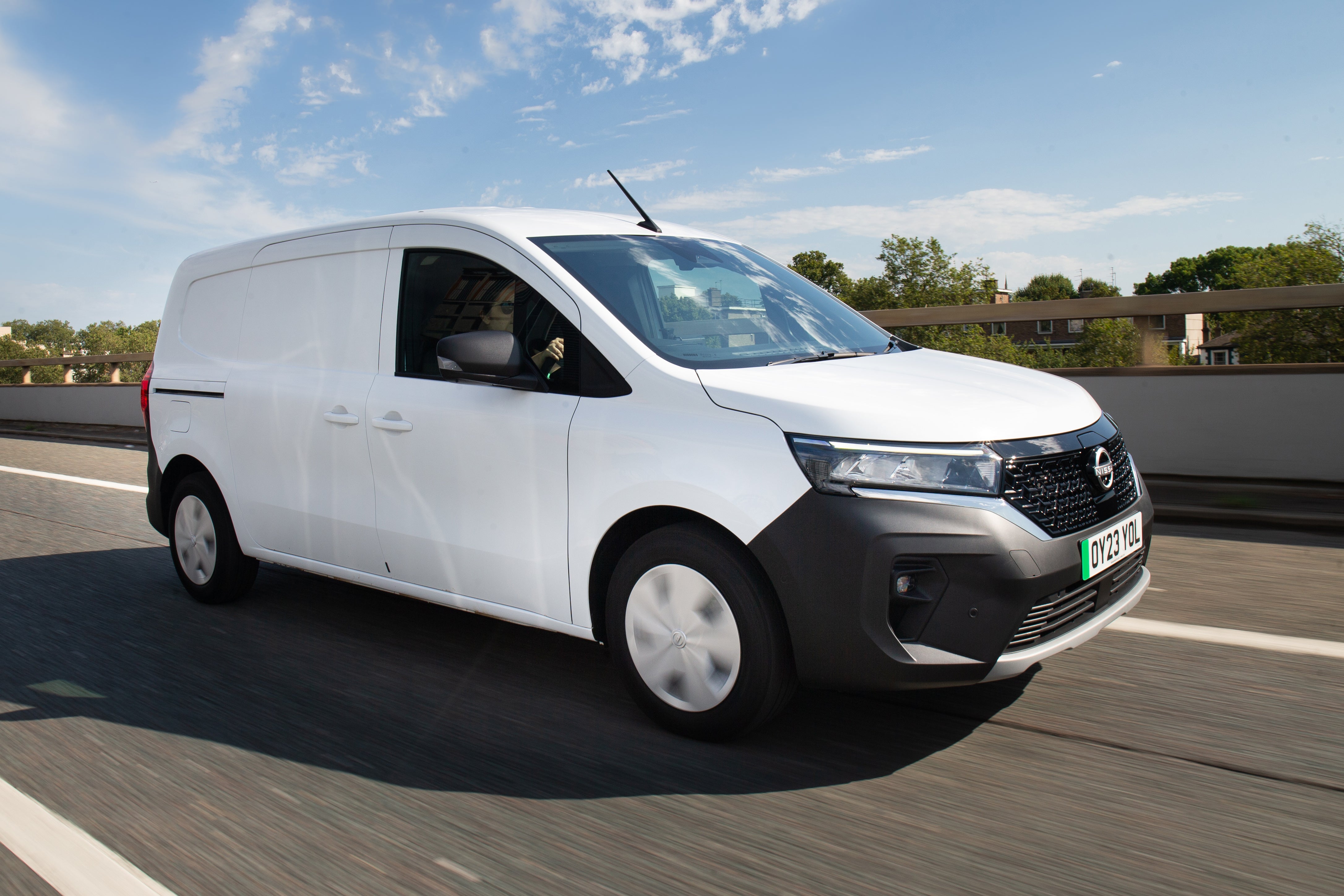Nissan Townstar Review 2024
Written by Ivan Aistrop
Quick overview
Pros
- Comfortable ride
- Competitive practicality
- Generous equipment
Cons
- EV much more expensive than petrol
- Low payload on EV
- Bland interior colour scheme
Overall verdict on the Nissan Townstar
"The Nissan Townstar maybe isn’t the first name on the lips of many people looking for a compact van for their business, but perhaps it should be. It’s a very good all-rounder, but has a couple of areas of real strength that make it really compelling. Find out what they are in our 2024 Nissan Townstar review."
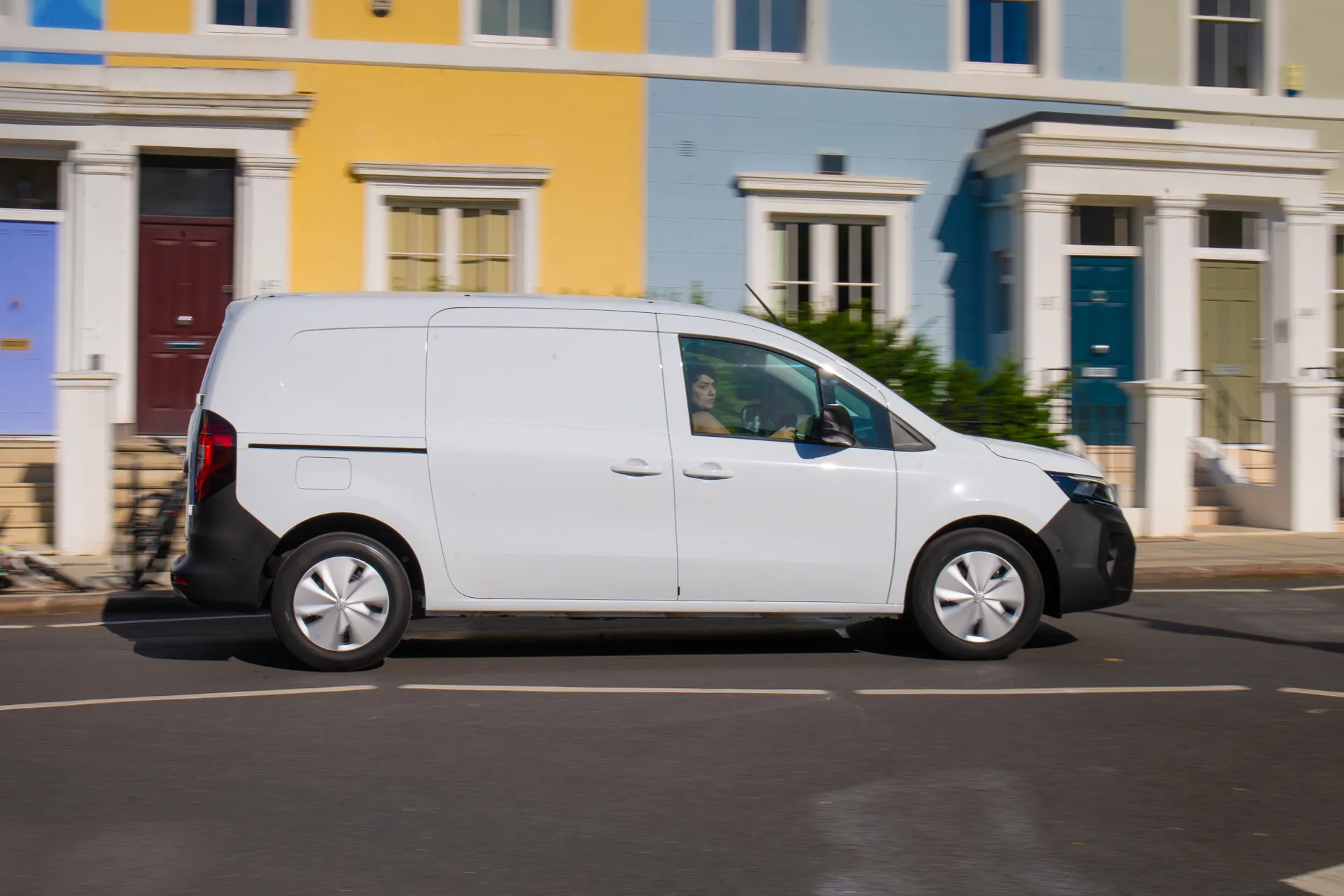
Like with most vans, though, the Nissan Townstar isn’t exactly unique. The process of badge-engineering - where manufacturers team up to share the costs of developing and building a vehicle, resulting in those companies selling mechanically identical vehicles differentiated only by the badges they wear - is common throughout the motor industry, and is especially rife in the commercial vehicle sector. So, just like a Ford Transit Connect is mechanically identical to a Volkswagen Caddy Cargo, and a Citroen Berlingo Van is mechanically identical to a Peugeot Partner (And a Vauxhall Combo. And a Fiat Doblo. And a Toyota Proace City), the Nissan Townstar shares its innards and oily bits with the Renault Kangoo and Mercedes Citan. And what’s more, all of these vehicles could be considered rivals.
So in such a crowded marketplace, how does the Nissan Townstar stand out? Well, for starters, by being competitive in pretty much every area. Practicality and versatility is perhaps the most important area for any commercial vehicle, and the Townstar is right up there on that score, with generous load bay dimensions and capacity, plus thoughtful touches to make the space more usable.
It’s also solidly built from durable (if not particularly plush) materials, so it’ll stand up well to hard daily use, and it comes with a better-than-average five-year, 100,000-mile warranty.
It also offers you choice over how you want your van to be powered. For those who need to cover longer distances, a petrol engine is offered (there’s no diesel option, though), while those whose work is concentrated within the city limits can take advantage of a Nissan Townstar with an all-electric powertrain.
As well as being competitive in most areas, the Nissan Townstar also manages to excel in a couple. First off, it’s well equipped: the entry-level version comes with all the essentials, plus a couple of luxuries you might not expect, while the high-end versions feel borderline luxurious.
It’s also an immensely comfortable vehicle to pootle around in thanks to a soft suspension that’s brilliant at soaking up lumps and bumps. Chuck in accurate steering, light controls and reasonable performance, and it’s also a very easy vehicle to drive, and all that is super-important when you spend large portions of your working day at the wheel.
Okay, so the Nissan Townstar is not perfect. The electric version is lots more expensive than the petrol, and has a significantly reduced payload. Even so, though, for the right sort of person with the right sort of business, the Nissan Townstar will still suit.
Looking for a used van for sale? We've got 100s of Nissan Approved Used Cars for Sale for you to choose from, including a wide range of Nissan Townstar vans for sale.
Is the Nissan Townstar right for you?
If your business is such that you need the space and versatility of a van but you don’t need the enormous space that a large van affords, then a compact van is a good solution. And of the compact vans on the market currently, we reckon the Nissan Townstar is one of the better ones. It’s especially impressive for ride comfort and equipment, and it’s competitive in all the other important areas, too.
What’s the best Nissan Townstar model/engine to choose?
So far, we’ve only tried the all-electric Nissan Townstar EV. That means we can’t tell you if it’s any better than the petrol-powered version, but there’s certainly very little wrong with it, so it’s easy to recommend if you can live with the limited range.
In terms of trim level, the Acenta gets most of the basics, but the reversing camera and all-round parking sensors of the Tekna do make parking manoeuvres much easier, and are worth the upgrade as a result.
What other cars are similar to the Nissan Townstar?
There are two vehicles that are extremely similar to the Nissan Townstar, and those are the Renault Kangoo and the Mercedes-Benz Citan. Why? Because underneath their respective skins, the three are all mechanically identical.
Ford offers a couple of rivals in the form of the Transit Courier and the Transit Connect. The latter is a smidge bigger than the former, but there’s very little in it. The latter also shares its mechanicals with the Volkswagen Caddy Cargo, so has to be considered as another rival.
Then there’s the group coming out of the Stellantis stable, those being the Citroen Berlingo, the Peugeot Partner and the Vauxhall Combo. Toyota isn’t part of Stellantis, but nevertheless, it offers another version of the same van called the Proace City.
Comfort and design: Nissan Townstar interior
“There’s plenty of adjustment on both the driver’s seat and steering wheel, so drivers of all shapes and sizes will be able to get comfy. In some vans, tall drivers are prevented from sliding their seat back far enough by the metal bulkhead behind them, but that’s not the case in the Townstar because there’s a decent amount of space between those two items.”
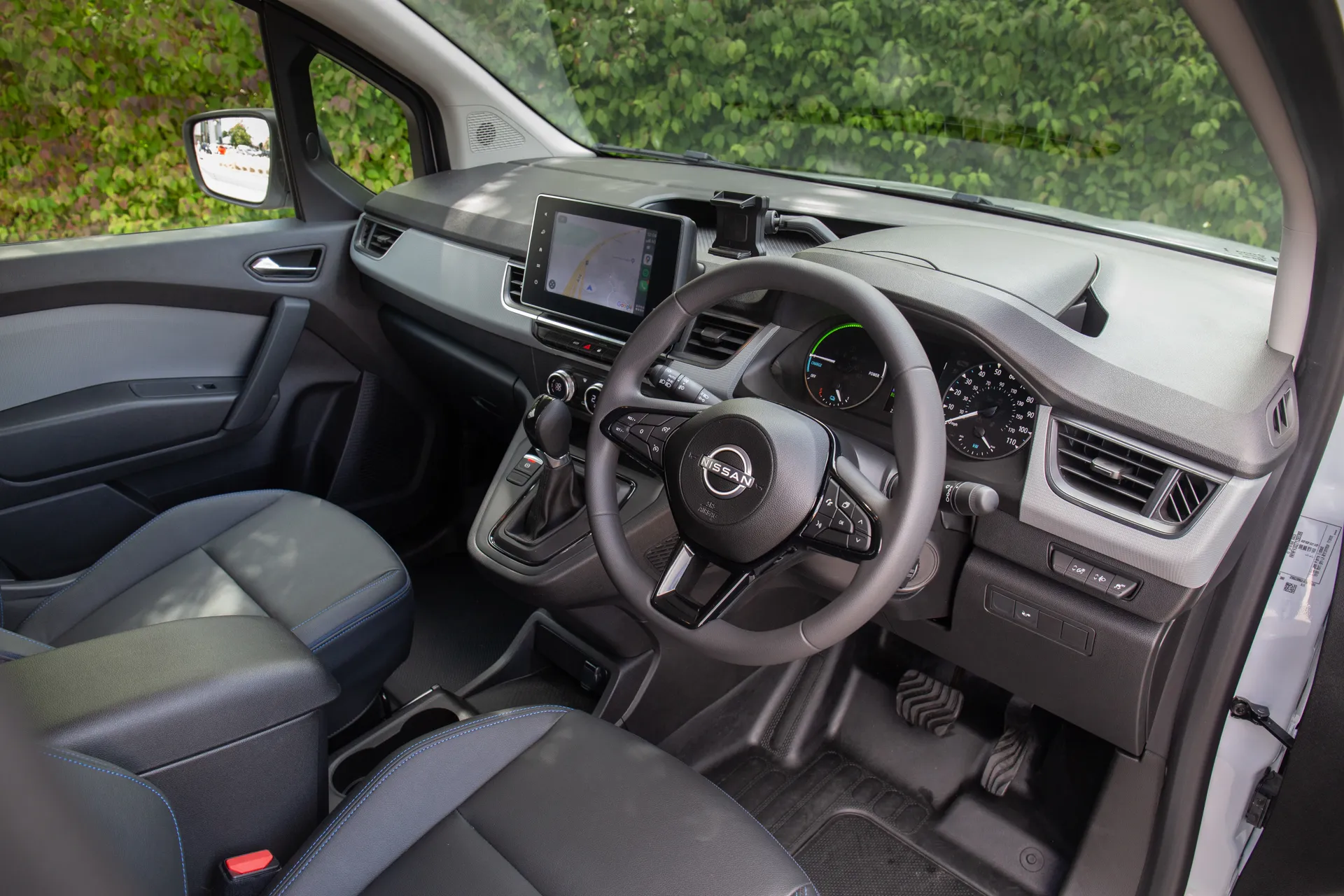
Obviously, that bulkhead means your rear visibility is limited to what you can see in your door mirrors, which aren’t as large as they are on some vans, but they can be adjusted electrically. The entry-level Acenta version has rear parking sensors to help with manoeuvres, while the Tekna gets a reversing camera and all-round sensors, and the Tekna+ gets a 360-degree camera system. Visibility to the front, meanwhile, is splendid thanks to the perched-up driving position and thin windscreen pillars with large quarter-light windows just behind them.
The Townstar can be had with either two- or three seats in the front, or as a Crew Van that sacrifices some of the loadbay for a second row of three seats . The one we tested was a two-seater, and had plenty of space for those two, but we reckon things might be rather more snug with three seats crammed in.
There’s a decent amount of storage, with shelves above the windscreen, reasonable door bins, a big glovebox, a cubby under the central armrest, a couple of shallow cupholders, and a large lidded cuddy on top of the dashboard behind the steering wheel. Rivals have more areas for odds and ends, though, and if you specify the three-seater version, you’ll lose half the ones we’ve mentioned.
Quality and finish
The interior of pretty much every commercial vehicle under the sun puts durability before tactility, and that’s no different in the Townstar. Yes, all the plastics are hard to the touch rather than being cushioned, but that means they won’t mark anywhere near as easily and they can be wiped clean. They look smart enough, too, and everything feels very solidly put together. Most of the buttons and switches feel substantial in the way they work, too, with the climate control dials feeling particularly slick. If we’ve one complaint, it’s that Nissan could’ve been a wee bit more imaginative with the colour scheme of the interior: it’s VERY grey in there.
Infotainment: Touchscreen, USB, nav and stereo in the Nissan Townstar
All versions of the Townstar come with the same 8.0-inch colour touchscreen in the middle of the dashboard, and it supports Bluetooth, DAB radio, Apple CarPlay and Android Auto. We couldn’t get our Android phone to connect with the latter, but to be fair, that might not have been the fault of the vehicle. Tekna and Tekna+ trim levels also have integrated navigation, which will come in handy if that should happen to you.
The graphics are a little dated, and not the sharpest, either, but they’re good enough to do the job and it’s reasonably easy to find your way around the system. The touch-sensitive shortcut icons on the left-hand side of the screen help on that score, as do fairly logical menu layouts. What’s more, while the system has all the functionality you want, it’s not absolutely rammed full of superfluous features, and that also helps make the system easy to navigate.
The old-school analogue dials of Acenta and Tekna might not give you the techy feelgood factor of fashionable digital instruments, but they’re as easy as pie to read and keep you well abreast of everything you need to know about. The Tenka+ does get digital instruments, and these do just as good a job and look a little flashier.
Space and practicality: Nissan Townstar boot space
The Nissan Townstar is a compact van, and in terms of dimensions, it’s 1,860mm wide (without door mirrors) and 1,864mm tall. There are two body lengths available, meanwhile, the L1 being 4,488mm long and the L2 being 4,910 long.
In terms of load area, you get 3.3 cubic metres of space in the L1 and 4.3 cubic metres in the L2. In both, the loadbay is 1,248mm wide between the rear wheelarches, and loadbay height stands at 1,215mm in the L1 and 1,229mm in the L2. Obviously, the bigger difference lies in the length of the loadbay, and this stands at 1,810mm in the L1 and 2,230mm in the L2. With those dimensions, both versions are capable of carrying two Europallets.
On the back of the Townstar, you’ll find twin side-hinged rear doors that can be opened up to 180 degrees if you unhook the stoppers built into the hinges, and this gives really good access to the loadbay. On top of that, all versions of the Townstar get sliding side doors on both sides of the vehicle for even better access: some vans only give you one of these, and some none at all. The L2’s sliding doors open a little wider than the L1’s and this bigger aperture allows you to load a Europallet through the side.
If you’re considering a petrol-powered Townstar, the maximum payloads are 725kg for the L1 and 762kg for the L2. That reduces by quite a bit on the all-electric version: 478kg for the L1 and 681kg for the L2.
Obviously, the Crew Van version (only available on the L2) is a rather different kettle of fish, because some of its cargo-carrying capacity is sacrificed for an extra row of seats. With all those seats in place, your loadspace length is 1,458mm long for a load volume of 2.1 cubic metres. However, when they’re not needed, those rear seats can be folded down to boost the loadbay to 2,000mm in length and 3.1 cubic metres in capacity. The payloads for the Crew Van are given at 805kg on the petrol and 679kg on the electric version.
Handling and ride quality: What is the Nissan Townstar like to drive?
“If you’re spending large portions of your working day at the wheel of your commercial vehicle, then comfort is by far and away the most important dynamic attribute it can have. Happily, that’s precisely where the Townstar excels.”
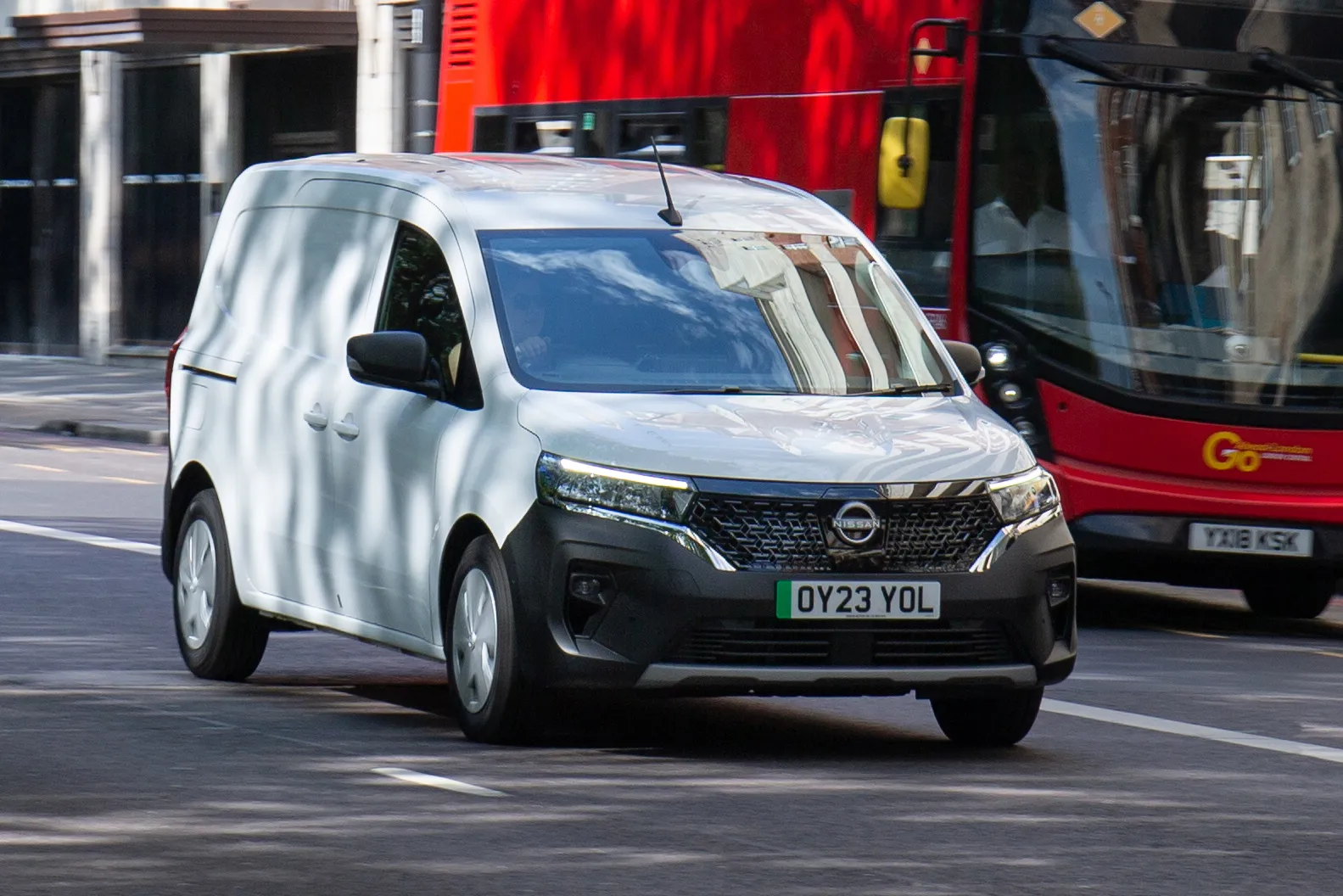
The softly sprung suspension does a brilliant job of isolating you from the effects of a scruffy road surface, smoothing out bumps and potholes in a really effective manner at all speeds.
However, that doesn’t come at the expense of sloppy body control. It doesn’t bounce you around over the dips and crests of an undulating road, staying controlled and stable at all times. Of course, the tall body will lean over a bit as you turn a corner, but it feels far from untidy and you’ll like how easy the steering is because it’s quick and light. There isn’t much feel, granted, but that’s hardly a pressing concern for a panel van.
What motors and batteries are available in the Nissan Townstar?
The electric version of the Nissan Townstar, the imaginatively named Townstar EV, has a 121PS electric motor powering the front wheels through a single-speed transmission, and it’s fed by a 45kWh lithium-ion battery pack.
According to the official figures, it’ll do the 0-60mph dash in 14 seconds in L1 form, or 15 seconds in the slightly heavier L2. That suggests very leisurely performance, but that’s not quite the full story. It actually feels much perkier than the numbers suggest when pulling away from the mark, where the strong and instantaneous torque from the electric motor can deliver its best effect. We reckon its 0-30mph time would actually be pretty quick, and it’s getting the rest of the way up to 60mph that takes up most of the official time.
You can feel that more leisurely unfurling of performance when trying to pick up speed on the move, but the Townstar EV never feels underpowered or out of its depth, and you’ll easily keep up with motorway traffic. Like with many EVs, the top speed is pretty low at 84mph.
The petrol-powered Townstar has a 1.3-litre four-cylinder turbocharged petrol engine that’s mated exclusively to a six-speed manual gearbox. Nissan doesn’t quote a 0-60mph or 0-62mph time for this version for some reason, but it has a higher top speed than the EV at 114mph. However, we haven’t tried this version yet, so we can’t tell you what it’s like.
Maximum electric range in the Nissan Townstar
The Nissan Townstar EV has quite a small battery at just 45kWh, so it’s range isn’t the biggest compared with most electric cars, although compared with other electric vans, it’s pretty competitive. The WLTP combined range is given at 183 miles combined, and a figure of 269 miles is said to be achievable when confined to city driving.
As always with EVs, though, you’ll see that figure plummet with prolonged motorway use, or when it’s cold outside.
Refinement and noise levels
Like with most electric vehicles, you’re in for a pretty quiet life with Nissan Townstar EV. You hear a bit of a whine from the motor as it spools up, but it's very quiet and distant at all times. You’ll plod through town very quietly indeed, with only the odd creak from the loadbay or clonk from the suspension for company.
Go faster, and you’ll hear a bit of wind noise fluttering around the windscreen at motorway speed, but it’s still fairly quiet and road noise is reasonably well contained as well. The electric Townstar is a pleasantly quiet way to travel, then, but we can’t comment on how refined the petrol version is because we haven’t tried it yet.
Safety equipment: How safe is the Nissan Townstar?
The Townstar gets a very decent amount of safety kit as standard, but precisely what you get depends on the trim level you go for. Acenta versions come with six airbags, automatic emergency braking, driver attention alert, traffic sign recognition, speed limit assistance, and reversing sensors.
Tekna trim adds a reversing camera and all-round parking sensors, while Tekna+ vehicles come with 360-degree cameras, adaptive cruise control, lane keep assist, blind spot assist and an automated parking function.
The Townstar has achieved the Gold standard (the second-highest you can get) in Euro NCAP’s commercial vehicle ratings. However, these are more about the provision and effectiveness of electronic driver aids, rather than crash safety.
MPG and fuel costs: What does a Nissan Townstar cost to run?
"Not all that long, actually, because as we’ve already said, the Townstar EV’s battery isn’t all that big at just 45kWh."
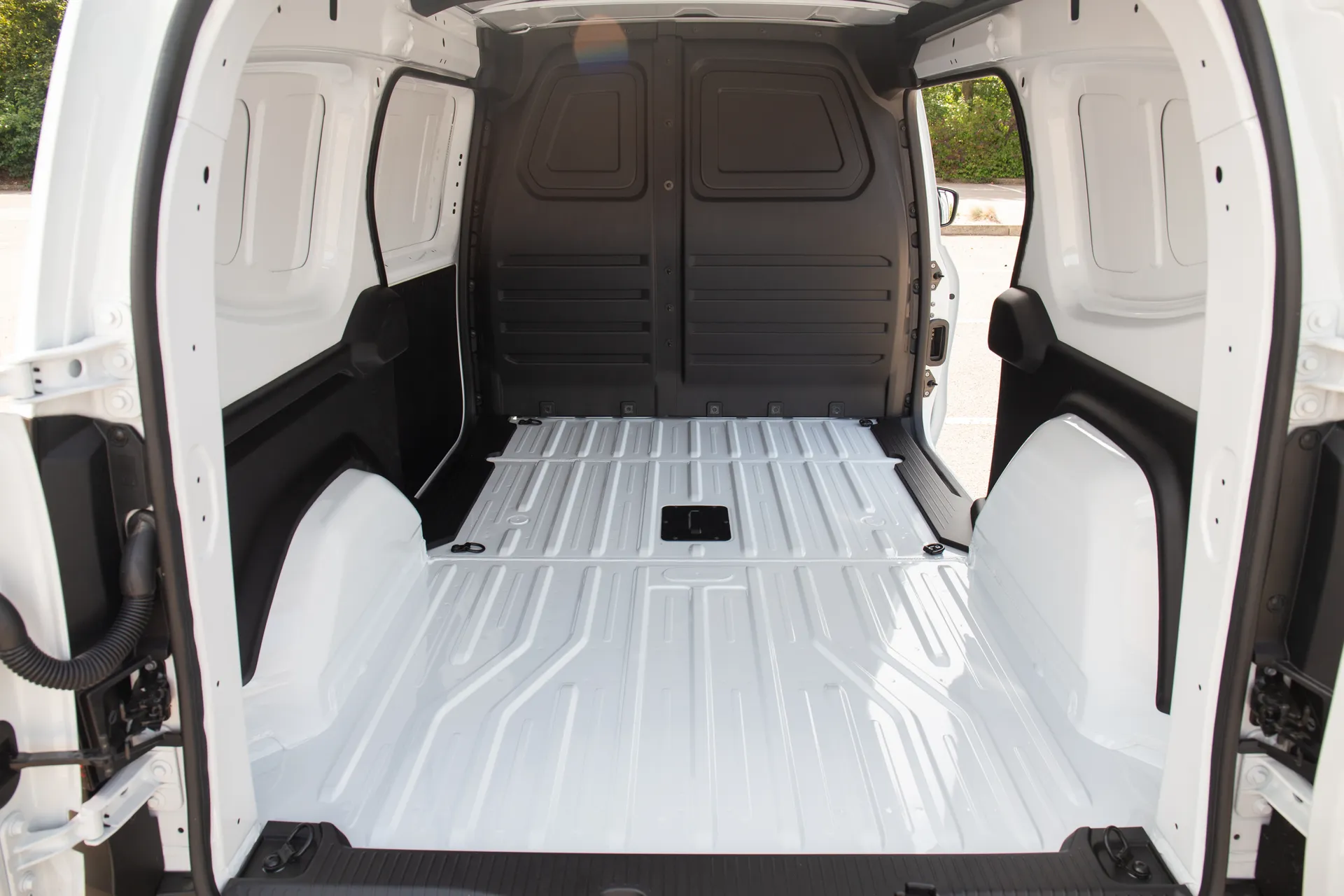
The CCS charging port, which has now become the European standard, is concealed behind the Nissan badge on the nose of the Townstar, and your standard equipment includes two charging cables. One is a Type 2 to Type 2 cable for plugging into home wallboxes and slower AC public chargers (on higher powered DC public chargers, the cable is usually built into the charger itself), and a cable with a Type 2 plug at one end to fit the vehicle, and a three-pin domestic plug at the other to fit into a regular household plug socket.
Use the latter, and a full charge will take ages (this is known as ‘granny charging’, somewhat uncharitably) due to the slow flow of domestic power. This 2.3kW hookup will take 26 hours to fully charge the battery. Do what most owners will do, however, and get a home wallbox charger fitted, and your charging speed will jump up to 7.4kW, meaning the time needed for a full charge comes down to seven hours.
Find yourself a slightly faster outlet, like you might get at slow public chargers or industrial sites, and the same charge comes down to four and a half hours on an 11kW hookup, or if you can find a 22kW outlet, then you’ll get a 15-80% charge in an hour and a half. The Townstar’s maximum DC rapid charging speed of 80kW isn’t great in the scheme of things, but the small battery means that same 15-80% top-up can be delivered in just 37 minutes.
How much it costs will depend entirely on how much you pay for your power. Charge the car at home on a tariff priced at the UK national average, and a full charge will cost about £12. Get yourself on a household tariff that allows you to charge overnight at a discounted rate, however, and you’ll probably pay half that, maybe even less. It flips the other way if you use public rapid chargers on a regular basis, because these can easily cost double what you’ll pay for domestic electricity.
If you buy the petrol-powered Townstar, you’ll probably want to know what kind of fuel economy it gets. Well, there’s a very slight difference between the L1 and L2 models, but both have an official WLTP figure of around 41mpg.
How reliable is the Nissan Townstar?
Take a look at the annual HonestJohn.co.uk Satisfaction Index, specifically the page listing the top-ten performing brands for reliability, and you’ll find that, with the exception of Dacia, all the brands on that list are Japanese or Korean.
Nissan, however, is one Japanese brand that doesn’t feature on that list. Then again, it doesn’t feature on the corresponding list of the ten worst-performing brands for reliability, so mid-table respectability it is.
It’s a similar story when you consider customer satisfaction as a whole: Nissan places 19th of the 29 carmakers included.
However, vans are intentionally designed to be basic so that they’re less likely to go wrong and cost their owners lost earnings due to time off the road. That should go double for the electric version, because its electric motor has only a handful of moving parts, opposed to the thousands you have in a combustion engine.
In fact Nissan offer a far more generous warranty on its commercial vehicles than it does on its cars, with cover for five years or 100,000 miles, rather than three years or 60,000 miles. The battery, meanwhile, is warranted to maintain 70% of its capacity for eight years or 100,000 miles.
Insurance groups and costs
Go for the petrol-powered Townstar, and your van will sit in insurance groups 27 or 28, depending on trim level. Go for the electric one, and it’ll be between 28 and 30. Considering there are 50 groups, of which 1 is the cheapest and 50 is the most expensive, then insurance premiums won’t be super-cheap, but they won’t be super-expensive, either.
VED car tax: What is the annual road tax on a Nissan Townstar?
As a light goods vehicle, the petrol-powered Nissan Townstar is liable for a flat rate of VED tax for such vehicles, which is currently charged at £335 per year. You’ll pay just over £350 if you elect to pay in instalments by direct debit, though, and around £370 if you choose to pay every six months rather than every year. That means it’s better to pay the single annual lump sum if you can.
If you go for the electric Townstar EV, however, you’ll pay nothing because electric vehicles are exempt. This will only remain the case until midway through 2024, though, at which point you’ll be stung for a similar amount of tax as with combustion-engined vehicles.
How much should you be paying for a Nissan Townstar?
"Brand new prices for the petrol-powered Townstar begin at around £21,000 for the Acenta, rising to around £22,500 for the Tekna and £24,000 for the Tekna+. The electric versions are, predictably, more expensive, with prices starting at £34,000 for the Acenta. That’s quite a jump."
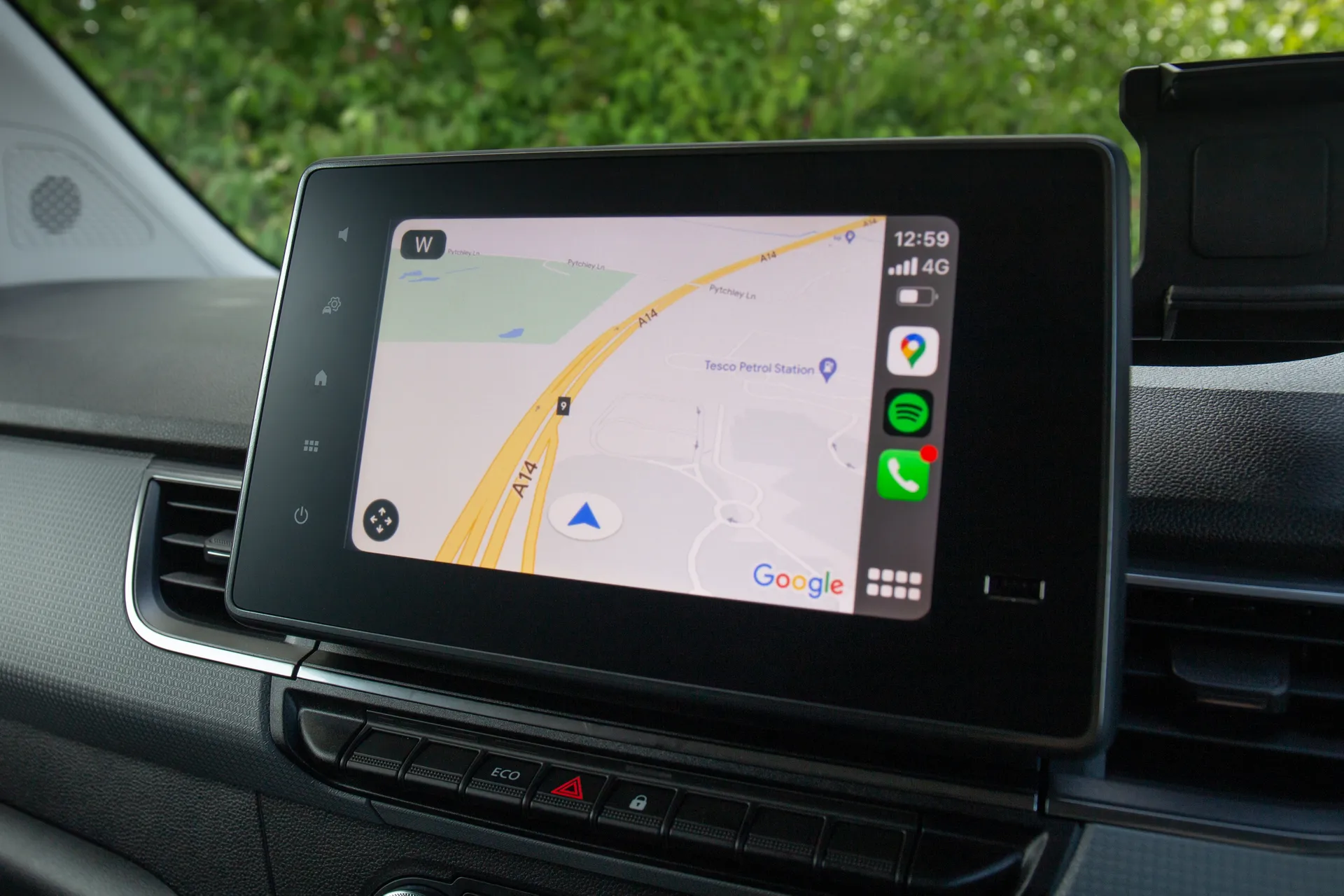
Take to the used market, though, and there are some huge savings to be made on the electric version. Take a look at the heycar classifieds, and you’ll find lots of as-new pre-registered examples with single-digit mileages, and some of them can be had for less than £20,000. These will be Acentas in a pretty bog-standard shade of white, but another £2,500 will get you into a Tekna-trimmed EV.
Petrols are in much shorter supply on the used market, partly because they haven’t been around as long, so the discounts are nowhere near as huge. In fact, you’ll be paying pretty much the same as you will for a brand new one.
Trim levels and standard equipment
The standard trim level is called Acenta, and this gets most of the essentials, along with a couple of little luxuries. The standard kit list includes steel wheels with trims, remote locking, climate control, powered windows, cruise control, reversing sensors, and automatic lights and wipers. That’s on top of all the infotainment kit and safety equipment we discussed earlier.
Mid-range Tekna trim gives slightly sharper looks with a body-coloured front bumper and door handles, while you also get keyless entry and go, sat nav, a reversing camera and all-round parking sensors.
Top-end Tekna+ trim adds 16-inch alloys, a leather steering wheel, 360-degree cameras, and the extra safety package.
Ask the heycar experts: common questions
What is the Nissan Townstar?
Is the Nissan Townstar the same as the Renault Kangoo and Mercedes-Benz Citan?
How big is the Nissan Townstar?
Get our latest advice, news and offers
Keep me updated by email with the latest advice, news and offers from heycar.
By submitting you agree to our privacy policy
